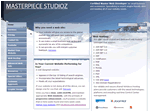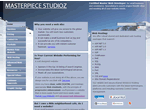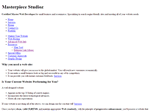Advanced Web Information
Advanced Web Information includes such techniques as Progressive Enhancement, increasing accessibility of content, mailing lists, utilizing the Delicious link library, and implementing findability techniques. By utilizing Advanced Web Information we can strengthen your web site and increase traffic to your site. Knowing how to keep the behavior, structure, and presentation separate is critical.
Progressive Enhancement
Progressive enhancement is the philosophy we use to create websites. It is based on the concept that each layer adds something, so it is an enhancement. The layers are independent of one another, so if a layer is removed, the user can still read the content. The progressive enhancement methodology of interface development helps users navigate and read a website’s content regardless of browser or device limitations. Knowing how to keep the behavior, structure, and presentation separate is critical. For an excellent example of Progressive Enhancement, go to LHChinesepaintings.com.

When creating complex JavaScript behaviors for an interface, using Rich Internet Applications, we begin by creating a semantically meaningful HTML document that communicates the information hierarchy of your page. By marking up your page with semantic tags, search engines will more easily understand your content.
Next we add a presentational layer using an external CSS file that creates the document design without altering HTML code. Then a behavior layer of JavaScript is added to enhance interactions of each the page.
By building your documents using this additive approach we keep them functional throughout each step. If CSS and JavaScript are not enabled, users can still see the content and understand the information hierarchy. When enabled, the JavaScript enhances interactions within a document.
Sites built with progressive enhancement help search engines index all content since JavaScript will no longer act as a roadblock. By externalizing CSS and JavaScript we also improve the indexing speed of a search engine. When CSS is downloaded once by search engine spiders, it is cached for faster reference with each additional page crawl.
With Flash, adding descriptive meta data to Flash files is handled by simply modifying the document settings before publishing by adding a title and description. Flash can be viewed as a fourth layer on top of the three-part progressive enhancement, enabling a rich interaction.
To show you the benefit of Progressive Enhancement, we have provided screen shots of the home page in different states. The first shows the page with all three layers, including HTML, JavaScript and CSS. In the second screen shot you will see what it looks like with JavaScript removed. In the third screen shot you will see what it looks like without Css and without JavaScript. Then you will see what it looks like when each layer is removed.
Accessible Content
As we’ve seen the Web mature, the request for content that can be easily accessed by users with disabilities or on alternate platforms has increased. We strongly believe in this accessibility and make full use of the tools that make it possible. Using accessibility techniques strengthens search engine indexing and often introduces more content into a page, enhancing search engine indexing. It makes images more visible, it removes roadblocks caused by image maps, it provides image replacement, it makes proper use of tables, and provides more keyword opportunities.
There are many things we do on the server side to improve the experience of users.
- The power of a name to file and folders
- Choosing and managing domain names
- Creating search engine friendly URLs
- Use 301 directs to move pages and domains
- Produce custom 404 pages to get users back on track
- Using consistent design throughout the site
- Including clear messages acknowledging the problem, indicating the possible cause, and providing solutions
- Include a search box so users can find what they are looking for
- Include a link to the home page
- Include a link to the site map that provides links to all the main sections of the site
- Include a way to report a broken link through a contact form link
We also do everything possible to optimize performance for efficient indexing. These action include:
- Getting clients to cache files
- Managing file size
- Compressing files with GZIP
- Reducing HTTP requests
- Diagnosing performance problems with YSlow
Web Analytics
You Have a Website—But How’s Your Traffic?
Most websites are not generating the traffic that website owners are expecting. The solution could be web analytics.
Through Masterpiece Studioz and web analytics, you’ll learn where your website is working and where it’s underperforming. Strategies are then developed that will continuously improve your Web rankings.
What is Web Analytics?
Web analytics is a tool that lets you check and monitor your online health. You’ll know what your visitors are experiencing. On many sites, visitors come to the home page or another page, and are gone in less than one minute, without visiting any other pages on the site. Knowing this and dozens of other pieces of information is the first step in making sure your website is producing a solid return on investment.
But My Site has Excellent Search Engine Optimization
Good search engine optimization is important, but it cannot replace the information provided by web analytics.
What Information can Web Analytics Provide?
- How to convert more visitors to customers
- How many daily visitors you receive and how they find your site
- Track metrics such as revenue, average order value, newsletter signups, page downloads
- Your average conversion rate (sales, registration, download, and so on)
- Your top-visited pages
- The average visit time on site and how often visitors come back
- The average visit page depth and how this varies by referrer
- Do visitors stay or simply bounce off after visiting a single page?
- Top referrers
- The revenue your site is generating
- The value of a web page
- Whether the site is engaging your visitors
- What key words are working best
Learn more about the capabilities and competitive advantages you can obtain through Web Analytics
Style Sheet Switchers
A style sheet switcher adds an interesting dimension to your website and lets you stand apart from all the typical sites on the Internet. A style sheet switcher allows you to feature your standard layout (or style sheet), but lets your visitors choose the way they view your site. Changing the style sheet can transform the look and feel of your site. People like options.
To understand what we mean, look at what we call the Season Switcher™ in use on the Masterpiece Studioz website. On the far right side click on the season selector and then select any of the four seasons. Notice how you instantly view the season you’ve chosen. We can create a Season Switcher™ for you as well as numerous other switchers, giving your visitors a look and feel that works best for them.
The visitor simply views the options and chooses one. From that point on a persistent cookie stores the user’s choice and recalls that style sheet automatically each time the person returns.
The creation of a style sheet switcher requires four features. 1) The Progressive Enhancement technique must be used throughout the website so that it is built layer by layer; 2) It has clean HTML for all data; 3) It uses Continuous Style Sheet (CSS) for styling the website; 4) It uses Java Script with the cookie.
Mailing List
We almost always recommend adding a mailing list to your site. It enables you to remain in contact with your audience and keeps them coming back. When you have something new to share, whether it is new content or an update of features, it’s the best way to get the word out and quickly generate traffic to your site. A mailing list enables you to build a relationship with fans in a way that is difficult to accomplish with any other tool.
“Delicious” Link Library
A link library is a collection of useful links to resources your users will find valuable. Because the user does not need to bookmark every link, you’ll get them returning to your dynamic, uptodate site more frequently. By using Delicious, a bookmark management service, you and your users can be assured that when they seek information on a topic, the top 20 links, at any given moment, will be offered with a click. Link libraries require no maintenance on your part.
To see an actual example of a Delicious Link Library on this site, click here.
Search
Search has become an essential means of navigation for most users and is expected on professional sites. One key technique that helps significantly is a search box so users can more easily and quickly find what they are looking for. Together we’ll consider several search systems options. With most, you can track the terms your users are searching for, enabling us to monitor user behavior.
With many search systems you can track terms that your users are searching for, providing insight into user behavior and any shortcomings in your site. By analyzing search statistics you can discover patterns in the terms your users are searching for. This can help you add content that will meet the desires of your audience, and usually leads to more traffic coming from search engines.
Once finding your site, it’s important to help your user find what they’ve come for. Adding a search system to your site is the easiest solution and will make your content more findable.
Web Standards
Web Stanards advocate best practices for building web sites and the recommendations published by the World Web Consortium (W3C).
W3C develops technical specifications and guidelines through a process designed to maximize consensus about the content of a technical report, to ensure high technical and editorial quality, and to earn endorsement by W3C and the broader community.


